PALEOMAGNETISM
(Part 2)
Mesa P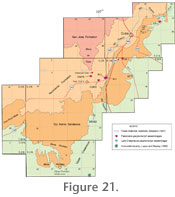 ortales Study Area ortales Study Area
Geography and Stratigraphy. Mesa Portales is about 17 km southwest of Cuba, New Mexico (Figure 3 and
Figure 21). The mesa is capped by the Paleocene Ojo Alamo Sandstone, which forms a gentle dip slope (from 1 to 1.5 degrees) dipping to the north; the south edge of the mesa is a steep, south-facing, 130 m high cliff face. The Upper Cretaceous Lewis Shale, Pictured Cliffs Sandstone, and the undivided Fruitland and Kirtland Formations underlie the Ojo Alamo and are well exposed at this locality. These exposures are within the Mesa Portales study area (Figure 21).
Fassett (1966) mapped the Ojo Alamo Sandstone on Mesa Portales and observed that it consisted of discontinuous, sheet-like, "overlapping massive beds of light- to rusty-brown fine- to coarse-grained sandstone that contain scattered silicified wood and conglomerate and are separated by light- to dark-gray and green shale."
 In the photograph of the Mesa Portales study area (Figure 22), the Ojo Alamo Sandstone is seen to consist of two sandstone benches; the upper bench is continuous whereas the lower bench pinches out to the east about one-third of the distance from the east edge of the photograph. On the geologic map of the Mesa Portales In the photograph of the Mesa Portales study area (Figure 22), the Ojo Alamo Sandstone is seen to consist of two sandstone benches; the upper bench is continuous whereas the lower bench pinches out to the east about one-third of the distance from the east edge of the photograph. On the geologic map of the Mesa Portales
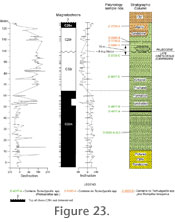 quadrangle (Fassett 1966), the base of the Ojo Alamo shifts from the base of the lower bench to the base of the upper bench where the lower bench pinches out. At other places on Mesa Portales, there are as many as five distinct sandstone benches included in the Ojo Alamo (Fassett 1966). Below the lowest sandstone bench (Figure 22) there is a discontinuous sandstone interval. This interval pinches out east and west of the area shown on
Figure 22. Even though the base of this sandstone interval clearly marks the Cretaceous-Tertiary interface at this locality, in other areas where this lower sandy interval is not present, there is a shale-on-shale contact marking that interface. Because this lower sandy interval is not a distinct, continuous, mappable unit, it was not included in the rock-stratigraphic Ojo Alamo Sandstone on Mesa Portales of
Fassett (1966). A detailed discussion of the Ojo Alamo Sandstone on Mesa Portales is in
Fassett and Hinds (1971, p. 29-31). The Fruitland-Kirtland interval is only 100 m thick in the Mesa Portales study area (Figure 23), whereas this interval is 400 m thick in the Hunter Wash area to the northwest (Figure 3,
Figure 14). The thinning of this interval southeastward along the south rim of the San Juan Basin is discussed in detail in a separate section of this report. quadrangle (Fassett 1966), the base of the Ojo Alamo shifts from the base of the lower bench to the base of the upper bench where the lower bench pinches out. At other places on Mesa Portales, there are as many as five distinct sandstone benches included in the Ojo Alamo (Fassett 1966). Below the lowest sandstone bench (Figure 22) there is a discontinuous sandstone interval. This interval pinches out east and west of the area shown on
Figure 22. Even though the base of this sandstone interval clearly marks the Cretaceous-Tertiary interface at this locality, in other areas where this lower sandy interval is not present, there is a shale-on-shale contact marking that interface. Because this lower sandy interval is not a distinct, continuous, mappable unit, it was not included in the rock-stratigraphic Ojo Alamo Sandstone on Mesa Portales of
Fassett (1966). A detailed discussion of the Ojo Alamo Sandstone on Mesa Portales is in
Fassett and Hinds (1971, p. 29-31). The Fruitland-Kirtland interval is only 100 m thick in the Mesa Portales study area (Figure 23), whereas this interval is 400 m thick in the Hunter Wash area to the northwest (Figure 3,
Figure 14). The thinning of this interval southeastward along the south rim of the San Juan Basin is discussed in detail in a separate section of this report.
Paleomagnetic Analysis. Paleomagnetic sampling at Mesa Portales was conducted along a diagonal traverse (from lower left to upper right) up the face of the exposure shown on
Figure 22. Sample collection was conducted by E.M. Shoemaker (USGS), M.B. Steiner (U. Wyoming), and the author in 1983; in 1988, Steiner and the author collected additional samples to fill in gaps in the original 1983 sampling. The only publication resulting from this work was an abstract by
Shoemaker et al. (1984) summarizing the paleomagnetic data obtained at Mesa Portales in 1983.
Figure 23 shows the paleomagnetic data plot and a stratigraphic column for the Mesa Portales locality. Digging through the weathered-rock rind down to unweathered bedrock was required at many sample sites, generally to depths of about 0.1 m or so, but in some places to a meter or more. Samples of the freshly exposed bedrock were obtained by core drilling.
The following discussion of the paleomagnetic analysis of Mesa Portales samples is slightly modified from a report by M.B. Steiner (personal commun., 1989).
Natural remanent magnetism (NRM) directions for Mesa Portales samples varied between Cretaceous normal, axial field, present field, and Late Cretaceous and early Paleocene reversed
and normal directions. A reversal from normal polarity to reversed polarity was found in the NRM directions in the Cretaceous part of the section (Fruitland-Kirtland Formations) between 60 m and 68 m above the base of the sampled section (Figure 23); this reversal is estimated to be at the 64 m level (Figure 23). Another reversal, from reversed to normal polarity, was discovered in the Paleocene Ojo Alamo Sandstone between the 119 m and 122 m levels (Figure 23); this reversal is placed at the 121 m level.
NRM intensities were typically 1 x 10-3 AIM (l x10-6 emu/cc). A small number of samples from both sandstone and mudstone beds had intensities of 1 x 10-2 AIM (10-5 emu/cc) and some ranged down to 1 x 10-4 AIM (10-7 emu/cc). Intensities of heavy-mineral laminae were as much as 2 x 10-1 AIM (2 x 10- 4 emu/cc). NRM directions of these layers were clearly of Late Cretaceous-earliest Paleocene origin.
Pilot samples were demagnetized using alternating field (AF) and thermal demagnetization. Ten samples were AF demagnetized to 100 mT (1000 oe). Thirty samples were thermally demagnetized in steps of 25 degrees between 150° C and 400° C. Another 32 samples were thermally demagnetized to 200° C and then AF demagnetized to 15 mT. The remainder of the samples was thermally demagnetized in five steps between 170° C and 325° C. Subtracted vectors were computed between demagnetization steps, and characteristic directions were determined by a least-squares analysis of lines fit to the demagnetization trajectories.
AF demagnetization indicated a median demagnetizing field of between 12.5 and 20 mT. Demagnetization to as high as 100 mT, however, did not always engender stable directions and (or) decay to the origin of orthogonal axes plots. Thermal demagnetization was performed on specimens cut from the same core as the samples that were AF demagnetized. These data displayed the same direction as AF treatment for those samples for which AF caused decay to the origin; for those specimens that did not, thermal demagnetization revealed a trend (generally incomplete) toward an apparent reversed-polarity magnetization. Thermal demagnetization indicated a magnetization component stable between 200° C and 300° C, having antipodal directions.
Another group of samples was thermally demagnetized to 200° C and then AF demagnetized to 15 mT. The directions at 200° C are generally representative of the normal or reversed directions later shown to be characteristic from wholesale thermal demagnetization. Further demagnetization of the 200° C thermally demagnetized samples by AF demagnetization to 15 mT did not reduce intensities further nor induce any appreciable continuation of the demagnetization trend begun by thermal demagnetization. Further thermal demagnetization above 200° C generally removed an additional amount of magnetization and continued the demagnetization trend begun below 200° C. In most cases, this demagnetization revealed a direction closer to the characteristic mean, but above 300° C an increasing dispersion of directions was observed. These findings indicate an antipodal magnetization with coercivities around 16 mT and unblocking temperatures between 200° C and 300° C and the presence of secondary magnetization(s) having higher coercivity and unblocking temperatures.
The greater effectiveness of thermal demagnetization dictated that the majority of samples be demagnetized by thermal means. As mentioned, the characteristic directions appeared to be held between 200° C and 300° C as is indicated in several ways: above 300° C, directions generally became erratic or diverged from a trend toward the origin. Moreover, visual inspection of the directions of the sample population at each temperature step indicated that the dispersion among directions began to increase at 300° C, and continued to increase with each succeeding temperature step. A 50% reduction in NRM intensity occurred between 200° C and 300° C for most normal, and some reversed, samples. Finally, the polarity sequences indicated by directions below 325° C is very simple, showing a well-defined change from normal to reversed polarity at 64 m above the base of the section in Cretaceous strata and from reversed to normal polarity at 121 m (Figure 23). The polarity sequences became more complex and stratigraphically inconsistent when directions above 300° C were considered.
Heavy mineral laminae in massive sandstone beds between about 70 and 84 m (Figure 23) were sampled extensively (21 samples). (These sandstone beds are the buff-colored beds seen just above the "C32r" label on
Figure 22.) The samples generally had clearly defined reversed directions with only minor influence of secondary magnetization on the NRM and remanence held below 300° C. As in the other samples from Mesa Portales, the characteristic magnetization is held between 200° C and 300°
C, above which the intensities diminish rapidly, and directions become more erratic. Several of the samples indicated the presence of two slightly different directions, one generally held below 300° C and the other above. The demagnetization trajectories of the heavy-mineral samples are more ragged than many other heavy-mineral laminae (Steiner 1983), which may reflect the superposition of the reversed overprint observed in the Mesa Portales section in general onto a primary reversed detrital or post-depositional remanence in these concentrates.
Curie temperatures were measured on the heavy mineral laminae collected at about 78 m above the base of the section. These displayed nearly reversible thermomagnetic curves with Curie/Neel temperatures of about 210° C. In a large-scale study of San Juan Basin sections,
Lindsay et al. (1981) stressed the necessity of collecting mudstones to ensure that good magnetic remanences
are obtained. The Cretaceous part of the Mesa Portales sequence (Figure 22 and
Figure 23) consists of mixed sandstone-mudstone lithologies and contains several massive sandstone beds in its upper part (Figure 22). To obtain an adequate sample-spacing pattern, large numbers of sandstone samples were collected in the section. Most of these samples were from the normal-polarity part of the section in the undivided Fruitland-Kirtland Formation. A comparison of directions and intensities of paleomagnetism of the mudstones and sandstones throughout the Mesa Portales stratigraphic section showed no differences in mean direction or polarity between the two lithologies. The uppermost (Paleocene) part of the Mesa Portales section is dominated by massive, cliff-forming sandstone beds (Figure 22 and
Figure 23); these beds were not sampled for paleomagnetic analysis.
Sample-site density for the entire section averaged about one site per meter except for two significant gaps between the 60 and 69 m level and the 98 to 108 m level (Figure 23). The lower 9 m gap is in the prominent white sandstone bed (Figure 22) that is above the coaly interval where the D-4017A, B palynologic samples were collected; the magnetic-polarity reversal from C33n to C32r falls within this white sandstone. The upper 10 m gap is mostly in the lower, sandy, Paleocene strata above the unconformity at the Cretaceous-Tertiary interface (Figure 22). When these two gaps are subtracted from the total-section thickness, sample-site spacing is about 0.80 m. Generally, three or more samples per site were collected.
The bulk of the paleomagnetic sample analysis was conducted by M.B. Steiner at the University of Wyoming paleomagnetism lab. Samples from selected intervals were also processed at the Caltech paleomagnetism lab by Joe Kirschvink for E.M. Shoemaker. Shoemaker stated (personal commun., 1984):
Enclosed is a listing of results on the Mesa Portales samples run at Caltech in Joe Kirschvink's laboratory. All samples were thermally demaged [demagnetized] first at 150° C, so we have a good record for this temperature. All of these (except KMP 0.01) were also demaged at 200°C; in all cases the shift in direction from 150° to 200°C is relatively small and the loss of magnetization less than 50%, usually much less than 50%. Hence, demagnetization to 200°C does not appear to be pushing too deep to retain the stable component of primary magnetization (Curie T = 180°C to 300°C according to Butler ["Butler" refers to
Butler and Lindsay 1985]). All samples were also AF demagnetized in steps to 150 Oe. Only samples 175.61 [54 m] and 183.0 [56 m] seemed to shift significantly toward the opposite polarity at these low fields.
The two samples at 54 m and 56 m (Figure 23) that "seemed to shift significantly toward the opposite polarity" are at about the same level below the top of C33n as the thin reversed-polarity interval seen at the Hunter Wash section (Figure 18).
Paleomagnetic Data Plot. The final plot of the magnetic polarity of the samples from Mesa Portales (Figure 23) incorporates both Steiner's and Shoemaker's data. This plot shows the presence of a normal-polarity interval from the base of the section in the Pictured Cliffs Sandstone to the 64 m level in the Fruitland-Kirtland sequence (Figure 23). This normal-polarity interval is overlain by a reversed-polarity interval extending to the K-T interface at the 100 m level. Another reversed-polarity interval extends from the K-T interface to just above the 120 m level; this reversed-polarity interval is overlain by a normal-polarity interval about 5 m thick that extends to the top of the paleomagnetic section. The normal and reversed intervals in the Cretaceous strata are identified as C33n and C32r as discussed in the
"Fassett and Steiner (1997) - Hunter Wash Paleomagnetic Section" section of this report.
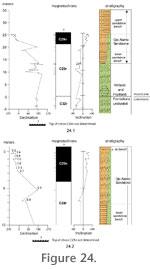 The Cretaceous part of the Mesa Portales paleomagnetic section bears a remarkable similarity to that part of the
Lindsay et al. (1981) Cretaceous section at their Hunter Wash/Alamo Wash locality and the
Fassett and Steiner (1997) section at Hunter Wash (Figure 18). The main difference is that the reversed-interval C32r is 61 m thick in the Ojo Alamo type area vs. 35 m thick at Mesa Portales. A zone of thin, reversed-polarity intervals in the upper part of C33n also is common to the Mesa Portales and Hunter Wash sections (Figure 18,
Figure 23). The Cretaceous part of the Mesa Portales paleomagnetic section bears a remarkable similarity to that part of the
Lindsay et al. (1981) Cretaceous section at their Hunter Wash/Alamo Wash locality and the
Fassett and Steiner (1997) section at Hunter Wash (Figure 18). The main difference is that the reversed-interval C32r is 61 m thick in the Ojo Alamo type area vs. 35 m thick at Mesa Portales. A zone of thin, reversed-polarity intervals in the upper part of C33n also is common to the Mesa Portales and Hunter Wash sections (Figure 18,
Figure 23).
The Paleocene part of the Mesa Portales data plot is shown at larger scales on
Figure 24. The distances, in meters, of paleomagnetic sample sites below the base of the upper Ojo Alamo Sandstone bench are shown on
Figure 24.2.
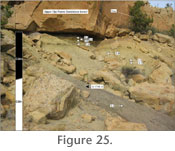 The reversed and normal magnetochrons above the Campanian-Paleocene interface are labeled C29r and C29n, respectively. (The identification of these chrons is discussed in the following section of this report.)
Figure 25 is an annotated photograph of the upper part of the Ojo Alamo Sandstone at Mesa Portales showing the locations of paleomagnetic sample sites on the upper cliff face. This figure shows that the paleomagnetic samples from the upper Ojo Alamo were collected from a relatively steep slope. Sample 5.3 was from a dark-gray mudstone, samples 2.7, 2.3, and 1.8 were from light-gray, silty mudstones, and the uppermost four samples were collected from a greenish-brown siltstone beneath the overhang of the upper Ojo
Alamo Sandstone bench; sample numbers are keyed to
Figure 24.2. The reversed and normal magnetochrons above the Campanian-Paleocene interface are labeled C29r and C29n, respectively. (The identification of these chrons is discussed in the following section of this report.)
Figure 25 is an annotated photograph of the upper part of the Ojo Alamo Sandstone at Mesa Portales showing the locations of paleomagnetic sample sites on the upper cliff face. This figure shows that the paleomagnetic samples from the upper Ojo Alamo were collected from a relatively steep slope. Sample 5.3 was from a dark-gray mudstone, samples 2.7, 2.3, and 1.8 were from light-gray, silty mudstones, and the uppermost four samples were collected from a greenish-brown siltstone beneath the overhang of the upper Ojo
Alamo Sandstone bench; sample numbers are keyed to
Figure 24.2.
Figure 26
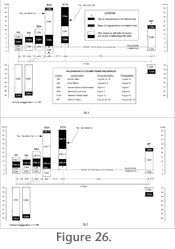 contains two cross sections that show paleomagnetic sections in the southern San Juan Basin that included the Ojo Alamo Sandstone.
Figure 26.1 shows the magnetochron labels of
Lindsay et al. (1981) and
Fassett and Steiner (1997).
Figure 26.2 shows the revised labeling of these magnetochrons of this report. The datum for these cross sections is the pre-Ojo-Alamo-Sandstone unconformity (Cretaceous-Paleocene interface). contains two cross sections that show paleomagnetic sections in the southern San Juan Basin that included the Ojo Alamo Sandstone.
Figure 26.1 shows the magnetochron labels of
Lindsay et al. (1981) and
Fassett and Steiner (1997).
Figure 26.2 shows the revised labeling of these magnetochrons of this report. The datum for these cross sections is the pre-Ojo-Alamo-Sandstone unconformity (Cretaceous-Paleocene interface).
Figure 27 shows the magnetic polarity of the lowermost Paleocene using all available data and using the base of chron C29n as a datum. HW data are from
Fassett and Steiner (1997). MP data are from this report, and all other paleomagnetic data are from
Lindsay et al. (1981). The labeling of the magnetochrons on
Figure 27 is different from publications by
Lindsay et al. (1981),
Butler and Lindsay (1985), and
Fassett and Steiner (1997). The lowermost normal-polarity interval in the Ojo Alamo Sandstone is here labeled C29n.2n. This chron was labeled C29n in
Lindsay et al. (1981), was deleted from the section in
Butler and Lindsay (1985), and was labeled C29n in
Fassett and Steiner (1997). The overlying reversed-polarity interval is labeled C29n.1r; this chron was called C28r in
Lindsay et al. (1981), was the upper part of C29r in
Butler and Lindsay (1985), and was C28r in
Fassett and Steiner (1997). C28r of
Figure 27 was C27r of
Lindsay et al. (1981), was C28r of
Butler and Lindsay (1985), and was not discussed in
Fassett and Steiner (1997). Chron C28n of
Figure 27 was C27n of
Lindsay et al. (1981) and C28n of
Butler and Lindsay (1985).
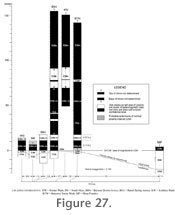 The magnetochron-numbering
scheme shown on Figure 27 is very
similar to that of
Butler
and Lindsay (1985), with one important difference. The lowermost normal
interval in the Paleocene; C29n.2n of
Figure 27, was deleted from the
Butler and Lindsay (1985) paleomagnetic section in the southern San Juan Basin, however, this thin normal interval has been found to be ubiquitous and virtually of the same thickness at all localities where paleomagnetic data have been obtained from the Ojo Alamo. The reversed-polarity interval: C29n.1r (Figure
27) is a newly identified reversed interval in the lower part of chron C29n. This interval, with a duration of about 0.07 m.y., has not been recognized in the basal part of C29n heretofore. The inclusion of chrons C29n.1r and C29n.2n in magnetochron C29n gives this chron an average thickness of about 70 m in the San Juan Basin (Figure
27). With a duration of 0.685 m.y. (Gradstein et al. 2004), the rock strata encompassing C29n has a sedimentation rate of 102 m/m.y. (not decompacted). This rate seems reasonable when compared to the sedimentation rate calculated for uppermost Cretaceous strata of 142 m/m.y. (Fassett 2000). Previous studies by
Lindsay et al. (1981)
and Fassett and Steiner (1997) assumed that the 11-m thick normal magnetochron in the lower Ojo Alamo Sandstone represented all of chron C29n. Using that thickness for C29n would yield a sedimentation rate of 16 m/m.y.; a rate that is unrealistically too low. The magnetochron-numbering
scheme shown on Figure 27 is very
similar to that of
Butler
and Lindsay (1985), with one important difference. The lowermost normal
interval in the Paleocene; C29n.2n of
Figure 27, was deleted from the
Butler and Lindsay (1985) paleomagnetic section in the southern San Juan Basin, however, this thin normal interval has been found to be ubiquitous and virtually of the same thickness at all localities where paleomagnetic data have been obtained from the Ojo Alamo. The reversed-polarity interval: C29n.1r (Figure
27) is a newly identified reversed interval in the lower part of chron C29n. This interval, with a duration of about 0.07 m.y., has not been recognized in the basal part of C29n heretofore. The inclusion of chrons C29n.1r and C29n.2n in magnetochron C29n gives this chron an average thickness of about 70 m in the San Juan Basin (Figure
27). With a duration of 0.685 m.y. (Gradstein et al. 2004), the rock strata encompassing C29n has a sedimentation rate of 102 m/m.y. (not decompacted). This rate seems reasonable when compared to the sedimentation rate calculated for uppermost Cretaceous strata of 142 m/m.y. (Fassett 2000). Previous studies by
Lindsay et al. (1981)
and Fassett and Steiner (1997) assumed that the 11-m thick normal magnetochron in the lower Ojo Alamo Sandstone represented all of chron C29n. Using that thickness for C29n would yield a sedimentation rate of 16 m/m.y.; a rate that is unrealistically too low.
The labeling of Paleocene magnetochrons shown on
Figure 27 is considered to be a best-fit interpretation of existing data. Other interpretations are possible, such as placing the lowermost Ojo Alamo Sandstone normal interval in magnetochron C29r and labeling it C29r.1n. Because the average thickness of C29n.2n is 11 m, and the thickness of C29n.1r is only about 7 m, it was thought that the placement of C29n.2n within C29n was the most parsimonious solution. It is clear that supplementary paleomagnetic studies of lowermost Paleocene strata in the San Juan Basin would be extremely useful in clarifying these relations. Most useful of all would be the precise dating of lower Paleocene strata in the basin using 40Ar/39Ar single-crystal-sanidine or other state-of-the-art radiometric-dating methods.
Figure 27 shows an irregular erosion surface at the base of the Paleocene across the basin with a 21 m topographic low on the pre-Paleocene land surface in the Mesa Portales area.
Fassett and Hinds (1971, figure 13) showed an isopach map of the interval from the Huerfanito Bentonite Bed of the Lewis Shale to the base of the Ojo Alamo Sandstone (reproduced herein as
Figure 1.1); those authors suggested that because the Huerfanito Bed is a time plane (a volcanic ash fall into the Western Interior Seaway), this isopach map should represent the approximate topography of the land surface prior to deposition of the Ojo Alamo Sandstone.
Fassett (1985) discussed the evolution of the pre-Ojo Alamo Sandstone erosion surface and offered illustrations (figures 3, 4) showing possible drainage patterns on that surface at the end of the pre-Ojo-Alamo-Sandstone erosion cycle. Fassett suggested in that paper that the strong perturbations (bulges to the east) of the 600 and 700 ft contour lines in the southeast part of the basin (Figure 1.1) represented erosion channels on the pre-Ojo-Alamo surface suggesting relatively high relief near the Mesa Portales area. Thus, the presence of 20 m of relief on the erosion surface in the Mesa Portales area is not unreasonable.
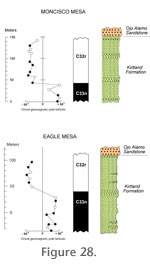 Moncisco Mesa and Eagle Mesa Localities Moncisco Mesa and Eagle Mesa Localities
Butler and Lindsay (1985) presented new paleomagnetic data from uppermost Cretaceous strata at two widely separated localities Moncisco Mesa and Eagle Mesa (Figure 1). The data plots for these two localities are shown on
Figure 28. At Moncisco Mesa, the sampled section is 140 m long and contains 16 sample sites; a sample spacing of about 9 m. At Eagle Mesa the section is about 80 m long and contains 16 sample sites for a spacing of 5 m. Apparently, the intent of
Butler and Lindsay (1985) at these two sections was to locate the boundary between the normal and reversed polarity intervals in Cretaceous Kirtland Formation strata underlying the Ojo Alamo Sandstone. The wide spacing of samples at these two localities precluded the detection of the thinner normal and reversed polarity intervals seen in the Hunter Wash and Mesa Portales paleomagnetic sections.
Figure 29 is a
 cross section across the southwestern part of the San Juan Basin showing all of the paleomagnetic sections that extended deep enough into the Kirtland and Fruitland Formations to include chrons C32r and C33n (see
Figure 1 for locations of these sections). The complete paleomagnetic sections at the Moncisco Mesa, Eagle Mesa, and Mesa Portales localities are shown on
Figure 29. The lower parts of the Hunter Wash and Hunter Wash/Alamo Wash sections are not shown on this figure, but only contain more normal polarity (including the thin reversed-polarity interval discussed earlier) below the truncation points on the original data plots (Figure 18).
Figure 29 shows that the C32r interval thins from the MM to the MP column by 73 m, but that the thinning is not uniform. For example, C32r thins by 48 m from column MM to HW over a distance of 19 km (2.5 m/km), whereas the C32r interval only thins by another 25 m over a distance of 112 km (0.22 m/km) from column HW to MP.
Figure 30 is a reconstruction of
Figure 29 using the top of polarity chron C33n as a datum. This figure more accurately shows the southeastward truncation of the strata underlying the Cretaceous-Tertiary interface that preceded deposition of the Ojo Alamo Sandstone. cross section across the southwestern part of the San Juan Basin showing all of the paleomagnetic sections that extended deep enough into the Kirtland and Fruitland Formations to include chrons C32r and C33n (see
Figure 1 for locations of these sections). The complete paleomagnetic sections at the Moncisco Mesa, Eagle Mesa, and Mesa Portales localities are shown on
Figure 29. The lower parts of the Hunter Wash and Hunter Wash/Alamo Wash sections are not shown on this figure, but only contain more normal polarity (including the thin reversed-polarity interval discussed earlier) below the truncation points on the original data plots (Figure 18).
Figure 29 shows that the C32r interval thins from the MM to the MP column by 73 m, but that the thinning is not uniform. For example, C32r thins by 48 m from column MM to HW over a distance of 19 km (2.5 m/km), whereas the C32r interval only thins by another 25 m over a distance of 112 km (0.22 m/km) from column HW to MP.
Figure 30 is a reconstruction of
Figure 29 using the top of polarity chron C33n as a datum. This figure more accurately shows the southeastward truncation of the strata underlying the Cretaceous-Tertiary interface that preceded deposition of the Ojo Alamo Sandstone.
 A detailed discussion of the thinning of Upper Cretaceous rocks across the San Juan Basin (Figure 1) is presented in the following section of this report. Radiometric ages and palynologic data clearly indicate that the Maastrichtian and part of the uppermost Campanian are not present throughout most of the southern San Juan Basin representing a hiatus of nearly 8 m.y. at the K-T interface. Much of the missing strata was probably removed by erosion, however, there may also have been a reduced rate of deposition of uppermost Upper Cretaceous rocks in parts of the basin in latest Cretaceous (Maastrichtian) time. A detailed discussion of the thinning of Upper Cretaceous rocks across the San Juan Basin (Figure 1) is presented in the following section of this report. Radiometric ages and palynologic data clearly indicate that the Maastrichtian and part of the uppermost Campanian are not present throughout most of the southern San Juan Basin representing a hiatus of nearly 8 m.y. at the K-T interface. Much of the missing strata was probably removed by erosion, however, there may also have been a reduced rate of deposition of uppermost Upper Cretaceous rocks in parts of the basin in latest Cretaceous (Maastrichtian) time.
In their discussion of the Moncisco Mesa and Eagle Mesa paleomagnetic sections (neither of which included the Ojo Alamo Sandstone)
Butler and Lindsay (1985, p. 548) again state that the C29n normal chron (C29n.2n of
Figure 27) is in the Kirtland Formation. As discussed above, statements that chron C29n is in the Kirtland Formation differ from these author's previous placement of chron C29n within the Ojo Alamo Sandstone. Chron C29n was not found at Moncisco Mesa or Eagle Mesa because the Ojo Alamo Sandstone was clearly not sampled at those localities. This normal chron—C29.2n of this report—is clearly present within the Ojo Alamo Sandstone at Mesa Portales, only about 16 km east of Eagle Mesa.
Summary of San Juan Basin Paleomagnetism
Paleomagnetic studies of rock strata adjacent to the Cretaceous-Tertiary interface have been conducted at eight localities in the southern part of the San Juan Basin (Figure 1). At three of these localities Hunter Wash, Hunter Wash/Alamo Wash, and Mesa Portales the paleomagnetic sections include the lower part of the Paleocene Ojo Alamo Sandstone and as much as 150 m of underlying Cretaceous strata that include magnetochrons C32n and C33n (Figure 29,
Figure 30). In addition, chron C32r.1n may be present above the top of chron C33n at the Hunter Wash and Hunter Wash/Alamo Wash localities. At two other localities Moncisco Mesa and Eagle Mesa where only Cretaceous strata below the base of the Ojo Alamo were sampled, chrons C32r and C33n were identified (Figure 29). Chron C32r.1n was not identified at those places, probably because of the wide spacing of sample sites in those two sections.
At six localities (Figure 26,
Figure 27), a normal-polarity interval was found to be present in the lower part of the Ojo Alamo Sandstone. In the four sections where this normal interval was bracketed by reversed-polarity sites (Figure 26,
Figure 27), it is about 11 m thick. Biochronologic evidence (discussed below) unequivocally shows that the Ojo Alamo Sandstone is Paleocene, thus the normal-polarity interval in the lower Ojo Alamo is the lowermost part of chron C29n (herein labeled C29n.2n).
Butler and Lindsay (1985) recommended deleting the normal-polarity interval in the lower part of the Ojo Alamo (labeled chron C29n by
Lindsay et al. 1981,
1982) at three closely spaced localities South Mesa, Barnum Brown Amphitheater, and Barrel Spring Arroyo. These authors stated that their original studies were in error because these normal intervals did not represent true Paleocene remanent magnetism but were present-day-normal overprints. However, because this normal-polarity interval is also present in the Ojo Alamo Sandstone at three other widely spaced localities, it is not credible that these normal-polarity intervals in the lower Ojo Alamo at these six localities could all have been the result of present-day, normal-field, overprinting. The presence of chron C29n in the lower part of the Ojo Alamo Sandstone thus provides independent evidence that this formation, including its dinosaur-bearing parts at several localities, is Paleocene in age.
The Paleocene magnetochrons identified in the southern San Juan Basin have been reevaluated and relabeled as shown on
Figure 26 and
Figure 27. Magnetochron C29n is about 70 m thick and contains a persistent, 7 m thick reversed-polarity interval in its lower part, thus, C29n in the San Juan Basin consists of three subchrons: C29n.1n, C29n.1r, and C29n.2n (Figure 27).
Revised Magnetic-Polarity Calibration
 Figure 31 portrays a recalibration of paleomagnetic-reversal ages between the top of chron C33n and the base of chron C29r based on interpolation between two tie points: the precisely dated polarity reversal between chrons C33n and C32r (73.50 ± 0.19 Ma,
Fassett and Steiner 1997 and
Fassett 2000), and the age of the Cretaceous-Tertiary boundary (65.51 ± 0.01,
Hicks et al. 2002). The age of the C33n-C32r reversal was calculated on the basis of eight 40Ar/39Ar ages determined by J.D. Obradovich (USGS, retired) using the Taylor Creek Rhyolite as a standard with an assigned age of 28.32 Ma.
Figure 32 (from
Fassett 2000, figure 13) is a northeast-trending stratigraphic cross section across the San Juan Basin showing the positions of the eight dated ash beds from the Upper Cretaceous Lewis Shale, Fruitland, and Kirtland Formations. The stratigraphic positions of Western Interior ammonite zones and the Hunter Wash and Chimney Rock magnetic-polarity columns are also shown. Figure 31 portrays a recalibration of paleomagnetic-reversal ages between the top of chron C33n and the base of chron C29r based on interpolation between two tie points: the precisely dated polarity reversal between chrons C33n and C32r (73.50 ± 0.19 Ma,
Fassett and Steiner 1997 and
Fassett 2000), and the age of the Cretaceous-Tertiary boundary (65.51 ± 0.01,
Hicks et al. 2002). The age of the C33n-C32r reversal was calculated on the basis of eight 40Ar/39Ar ages determined by J.D. Obradovich (USGS, retired) using the Taylor Creek Rhyolite as a standard with an assigned age of 28.32 Ma.
Figure 32 (from
Fassett 2000, figure 13) is a northeast-trending stratigraphic cross section across the San Juan Basin showing the positions of the eight dated ash beds from the Upper Cretaceous Lewis Shale, Fruitland, and Kirtland Formations. The stratigraphic positions of Western Interior ammonite zones and the Hunter Wash and Chimney Rock magnetic-polarity columns are also shown.
The age of the K-T boundary was determined by
Hicks et al. (2002, p. 43) by normalizing "all available 40Ar/39Ar isotopic dates as published for the K-T boundary interval . . . based on the monitor age of 28.02 Ma for Fish Canyon Tuff and 28.32 Ma for Taylor Creek Rhyolite, which yields an average age of 65.51 ± 0.01 for the K-T boundary." The two tie points used to construct the calibrated magnetic-polarity column (Figure 31) are thus based on the same standards.
The global geologic time scale of
Gradstein et al. (2004) shows the correct age of 65.50 Ma for the K-T boundary but an incorrect age of 73.0 Ma for the C33n-C32r reversal—the correct age of this reversal is 73.50 Ma. The use of an incorrect age for the C33n-C32r reversal resulted in incorrect age assignments in
Gradstein et al. (2004) for the reversal ages between this reversal and the K-T boundary.
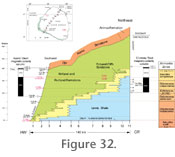 Ages for the paleomagnetic reversals shown on
Figure 31 are calibrated based on more precisely dated tie points and thus are considered to be the most accurate currently available for this time interval. It is recommended that the reversal ages for the Upper Cretaceous of
Figure 31 replace those of
Gradstein et al. (2004). Ages for the paleomagnetic reversals shown on
Figure 31 are calibrated based on more precisely dated tie points and thus are considered to be the most accurate currently available for this time interval. It is recommended that the reversal ages for the Upper Cretaceous of
Figure 31 replace those of
Gradstein et al. (2004).
The ages of uppermost Upper Cretaceous Western Interior ammonite zones of
Gradstein et al. (2004, table 19.3) are also not in agreement with the ages of these faunal zones in the San Juan Basin.
Figure 32 shows the positions of the Western Interior ammonite zones from Baculites scotti to Baculites compressus relative to a stratigraphic cross section encompassing the Lewis Shale, Pictured Cliffs Sandstone, and the Fruitland and Kirtland Formations. These ammonite-zone placements are from
Fassett (1987), based on the work of
Cobban (1973) and
Cobban et al. (1974). Time lines opposite ash-bed ages and ammonite-zone boundaries determined at outcrops in the San Juan Basin are projected into the subsurface of the basin. The highest ammonite-zone boundary shown on
Figure 32 is between the Didymoceras cheyennense and B. compressus zones. This boundary was located on the outcrop in the vicinity of Chimney Rock (Figure 32) by W.A. Cobban as discussed in
Fassett and Steiner (1997, p. 245). As seen on
Figure 32, the base of B. compressus is bracketed by the top of polarity chron C33n, with an age of 73.50 Ma and altered volcanic ash bed CR (in the underlying D. cheyennense zone) with an age of 74.25 Ma; these bracketing ages are from the same, continuous, stratigraphic section at a single locality. The base of B. compressus falls about halfway between these levels, thus the age of the base of B. compressus is estimated to be 73.90 Ma. The B. scotti-D. nebrascense ammonite-zone boundary was also located very precisely on the outcrop by Cobban, as reported in
Fassett et al. (1997) north of Cuba, New Mexico at the HBB (Huerfanito Bentonite Bed) locality shown on the inset map on
Figure 32. This ammonite-zone boundary is virtually at the same level as the Huerfanito Bentonite Bed of the Lewis Shale (Figure 32). The age of the Huerfanito Bed of 75.76 Ma was determined on the basis of samples collected at the same outcrop locality where the B. scotti-D. nebrascense boundary was located, thus the ammonite-zone boundary has been directly dated there. The duration of the interval from the base of the D. nebrascense zone to the base of the B. compressus zone is 1.86 m.y.
Gradstein et al. (2004, table 19.3) show the age of the base of B. compressus as 73.50 Ma and the base of D. nebrascense as 76.38 Ma for a duration of 2.88 m.y., or about 1 m.y. longer than the San Juan Basin interval. The base of the B. compressus zone of Gradstein et al. is 0.4 m.y. younger than the base of this zone in the San Juan Basin and the base of the D. nebrascense zone according to those authors is 0.62 m.y. older than in the San Juan Basin. Because the San Juan Basin ammonite-zone ages were determined at the same outcrops where the ammonite-zone boundaries were located (Figure 32), it is suggested that the San Juan Basin ages for these ammonite-zone boundaries are more precise.
The ages of the intervening ammonite-zone boundaries between the base of D. nebrascense and the base of B. compressus were calibrated by interpolation between the ages of ash bed CR and HBB in the Chimney Rock section (Figure 32).
Table 1 shows the ages and durations of the Western Interior ammonite zones determined in this report compared to the ages and durations of these same ammonite zones published in Gradstein et al. (2004). The more precise ages here reported for these boundaries supersede those of
Gradstein et al. (2004). The base of the B. scotti zone in the Lewis Shale has not yet been located in the San Juan Basin.
Lucas et al. (2006, p. 5) discussed the identification by
Lucas and Sealey (1992) of "ammonites of the D. cheyennense zone in the upper Lewis Shale near Cuba [NM]." This fossil locality is south of Mesa Portales (Figure 21) and is below the level of the Huerfanito Bentonite Bed there.
Figure 32 shows that the Huerfanito Bed is 75.76 Ma, as determined by
Fassett et al. (1997) who found that the Huerfanito Bed is almost exactly at the base of the D. nebrascense ammonite zone.
Table 1 shows that the base of the D. nebrascense zone is about 2 m.y. older than the D. cheyennense zone in the San Juan Basin. As discussed above, the ammonite-zone boundaries shown on Table 1 have all been precisely dated on the outcrop in the San Juan Basin. It is therefore not physically possible for the ammonite collections of
Lucas and Sealey (1992, and discussed in
Lucas et al. 2006) found south of Mesa Portales to be in the D. cheyennense zone. Moreover, USGS paleontologist W.A. Cobban visited this locality in 1997 accompanied by the author, Lucas, and Sealey and concluded that the fossil assemblage there was in the B. scotti Western Interior ammonite zone. Thus, it can only be concluded that the ammonite fossils found by
Lucas and Sealey (1992) at this locality were incorrectly identified.
|